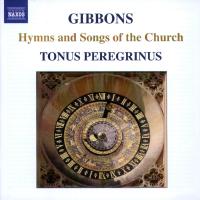
Gentle Chromaticism
Music by Orlando Gibbons,
reviewed by
PATRIC STANDFORD
Naxos 8.557681
|

|
Although Orlando Gibbons died shortly before his 42nd birthday (which, in 1625, was above the average life expectancy of 35, though he did live in East Anglia and thus avoided some of the perils of city living) his output was relatively small compared, say, with his near contemporary Thomas Morley who lived four years longer. He composed largely church anthems, but there were also the melody and some bass lines for seventeen Hymns (or Songs as he called them) that were published in a collection of Hymnes and Songs of the Church by George Wither in 1623. It is these that are here very attractively and cleverly arranged in a series of eight sequences, each rounded off with a different setting of Amen
[listen -- track 27, 0:00-0:15]
all drawn from the collection of director Antony Pitts whose family devised them, and many others, for their own mealtimes
[listen -- track 33, 0:00-0:13].
The sequences include Pitts' realisations of all the Gibbons Songs (except the few that are sung as unison lines) beautifully interspersed with original hymns by Anthony Pitts, his two brothers John and James, and Alexander L'Estrange, the countertenor of the ensemble -- and all with delightful stylistic and devotional cohesion. The gentle chromaticism that invades both the Gibbons arrangements and the new pieces assists each sequence to flow from then to now successfully, and in one case now was just three weeks before the recording session when Antony Pitts completed Hark, my soul!
[listen -- track 32, 1:01-1:33]
This new hymn ends the sixth sequence, Songs of unity.
Gibbons was an all time favourite composer of Glenn Gould, who was most fond of the hymn Song of Angels included in the group representing joy
[listen -- track 3, 0:00-0:45]
sounding well with inner parts by Pitts who also plays the chamber organ -- upon which there are occasional interludes based on the Gibbons melodies.
Other groups represent love, sacrifice, lamentation, triumph, faith and hope, that last short sequence including the Prayer of Hezekiah, one of several for which George Wither provided words, followed by the final Amen
[listen -- track 41, 0:43-1:22 and track 42, 0:00-0:17].
Some Gibbons songs make more than one appearance; No 13 in the Wither collection for instance is presented with two texts, one by Wither and the other by Frances Havergal, and is also used twice in contrasting organ interludes. The only small doubt in the Wither collection is whether Gibbons did write his 17th contribution, When one among the Twelve there was
[listen -- track 29, 0:00-0:30]
for it had appeared a few years earlier in a Welsh Psalter by Edmund Prys. But it matters little, and the Pitts arrangement is neatly made.
Copyright © 31 October 2006
Patric Standford, Wakefield UK

Orlando Gibbons: Hymnes and Songs of the Church
8.557681 DDD Stereo NEW RELEASE 71'42" 2006 Naxos Rights International Ltd
Tonus Peregrinus: Joanna Forbes, soprano; Rebecca Hickey, soprano; Kathryn Oswald, alto; Alexander L'Estrange, countertenor and double bass; Richard Eteson, tenor; Alexander Hickey, tenor; Francis Brett, bass; Nick Flower, bass; Antony Pitts, director and chamber organ (John Byfield, London 1766, Finchcocks Collection)
Orlando Gibbons (1583-1625): Complete melodies, as published in 1623, with new realisations and original settings by Alexander L'Estrange and Antony Pitts, organised as Songs of joy; Songs of love; Songs of sacrifice; Songs of lamentation; Songs of triumph; Songs of unity; Songs of faith; Songs of hope |
BUY THIS CD ONLINE
SCORE DOWNLOADS FROM TONUS PEREGRINUS
THE KEYBOARD MUSIC OF ORLANDO GIBBONS
PRIORY'S COMPLETE NEW ENGLISH HYMNAL
Record Box is Music & Vision's
regular series of shorter CD reviews
|

